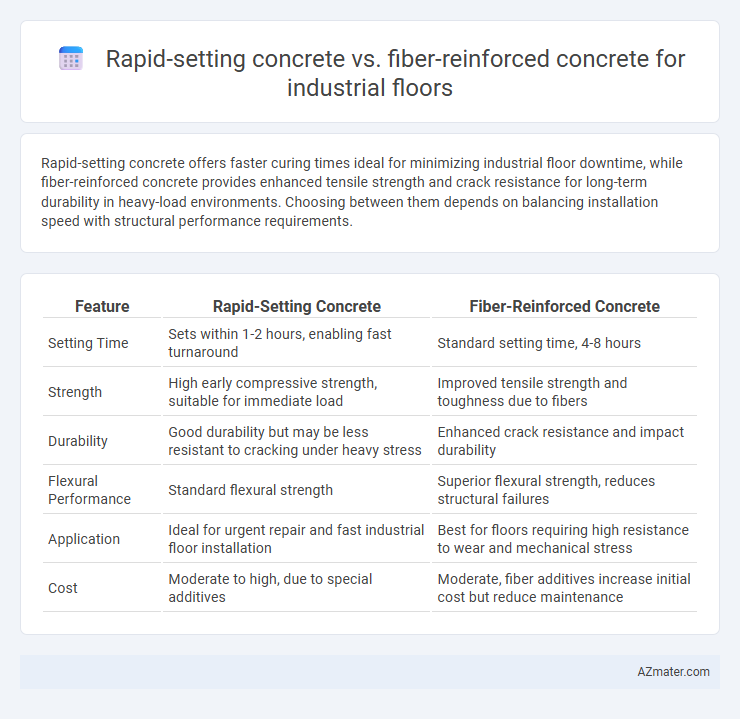Rapid-setting concrete offers faster curing times ideal for minimizing industrial floor downtime, while fiber-reinforced concrete provides enhanced tensile strength and crack resistance for long-term durability in heavy-load environments. Choosing between them depends on balancing installation speed with structural performance requirements.
Table of Comparison
| Feature | Rapid-Setting Concrete | Fiber-Reinforced Concrete |
|---|---|---|
| Setting Time | Sets within 1-2 hours, enabling fast turnaround | Standard setting time, 4-8 hours |
| Strength | High early compressive strength, suitable for immediate load | Improved tensile strength and toughness due to fibers |
| Durability | Good durability but may be less resistant to cracking under heavy stress | Enhanced crack resistance and impact durability |
| Flexural Performance | Standard flexural strength | Superior flexural strength, reduces structural failures |
| Application | Ideal for urgent repair and fast industrial floor installation | Best for floors requiring high resistance to wear and mechanical stress |
| Cost | Moderate to high, due to special additives | Moderate, fiber additives increase initial cost but reduce maintenance |
Introduction to Industrial Flooring Solutions
Rapid-setting concrete offers accelerated curing times ideal for minimizing downtime in industrial floor installations, ensuring quick return to service. Fiber-reinforced concrete enhances tensile strength and crack resistance, improving durability under heavy machinery and high traffic conditions. Both solutions provide tailored performance benefits critical for optimizing industrial flooring longevity and operational efficiency.
Overview of Rapid-Setting Concrete
Rapid-setting concrete provides industrial floors with accelerated curing times, allowing for quicker project completion and reduced downtime in busy facilities. This type of concrete achieves high early strength through specialized cementitious materials and additives that promote fast hydration, making it ideal for repairs and emergency work. Its rapid strength development enhances durability and load-bearing capacity, essential for heavy machinery and high-traffic industrial environments.
Key Features of Fiber-Reinforced Concrete
Fiber-reinforced concrete for industrial floors incorporates synthetic or steel fibers that enhance tensile strength, crack resistance, and durability under heavy loads. This type of concrete offers improved impact resistance and minimizes shrinkage, making it ideal for high-traffic and abrasive environments. Compared to rapid-setting concrete, fiber-reinforced concrete provides long-term structural integrity and reduced maintenance costs in industrial applications.
Installation Time Comparison
Rapid-setting concrete offers significantly faster curing times, typically reaching sufficient strength within 2 to 4 hours, enabling quicker industrial floor installation and reduced downtime. Fiber-reinforced concrete, while enhancing durability and crack resistance, generally requires standard curing periods of 24 to 48 hours, resulting in longer installation timelines. Choosing rapid-setting concrete optimizes project schedules where time-sensitive operations demand expedited floor readiness.
Durability and Crack Resistance
Rapid-setting concrete offers accelerated strength gain, making it ideal for industrial floors requiring quick turnaround, but it typically has lower long-term durability and higher susceptibility to shrinkage cracks under heavy loads. Fiber-reinforced concrete enhances durability through improved tensile strength and crack resistance, distributing stress more evenly and limiting crack propagation in industrial floor slabs exposed to dynamic and heavy machinery. Choosing fiber-reinforced concrete ensures extended service life and reduced maintenance costs due to superior crack control and resistance to wear in demanding industrial environments.
Load-Bearing Capacity
Rapid-setting concrete offers quicker load-bearing capacity, allowing industrial floors to support heavy machinery and vehicular traffic within hours, ideal for minimizing downtime in fast-paced environments. Fiber-reinforced concrete enhances load distribution and crack resistance, improving overall durability and reducing maintenance requirements under repetitive industrial loads. Combining rapid-setting properties with fiber reinforcement can optimize both early strength and long-term performance for industrial floors.
Maintenance and Longevity
Rapid-setting concrete offers faster curing times, reducing downtime for industrial floor maintenance, but may require more frequent surface repairs due to lower flexural strength. Fiber-reinforced concrete enhances durability and crack resistance, significantly extending the lifespan of industrial floors while minimizing maintenance efforts related to structural damage. Choosing fiber-reinforced concrete provides improved long-term performance in industrial environments with heavy mechanical stress.
Cost Efficiency Analysis
Rapid-setting concrete offers superior cost efficiency for industrial floors due to its significantly reduced curing time, enabling faster project completion and lower labor expenses. Fiber-reinforced concrete enhances durability and reduces maintenance costs over time by improving tensile strength and crack resistance, which can lead to long-term savings despite higher initial material costs. Choosing between rapid-setting and fiber-reinforced concrete depends on balancing upfront investment against long-term performance and maintenance requirements specific to industrial flooring applications.
Best Applications for Each Material
Rapid-setting concrete excels in industrial floors requiring fast turnaround, such as emergency repairs or installations in high-traffic facilities, due to its quick curing time of under 24 hours. Fiber-reinforced concrete is ideal for industrial floors exposed to heavy loads, abrasion, and shrinkage cracking because the embedded fibers enhance tensile strength and durability. Selecting between these materials depends on project timelines and performance demands, with rapid-setting concrete suited for speed and fiber-reinforced concrete optimized for long-term structural resilience.
Conclusion: Choosing the Right Concrete for Industrial Floors
Rapid-setting concrete offers accelerated strength gain and reduced downtime, making it ideal for projects requiring quick turnaround times in industrial floor construction. Fiber-reinforced concrete enhances durability and crack resistance, providing long-term structural integrity under heavy loads and dynamic stress. Selecting between rapid-setting and fiber-reinforced concrete depends on balancing the need for fast installation versus enhanced performance and lifespan in demanding industrial environments.

Infographic: Rapid-setting concrete vs Fiber-reinforced concrete for Industrial floor
 azmater.com
azmater.com